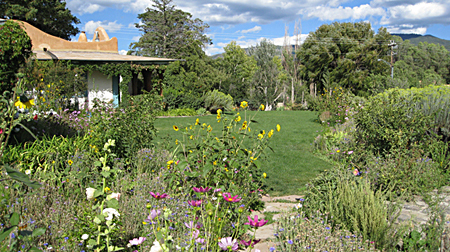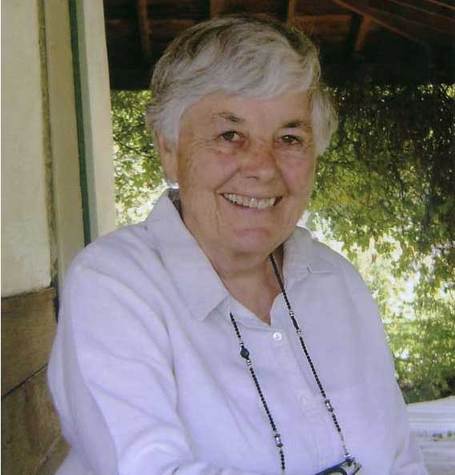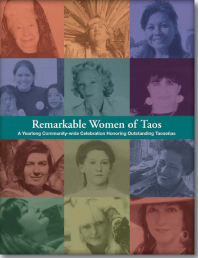Virginia Couse Leavitt, Founder of the Couse Foundation
Virginia Couse Leavitt and her grandmother, Virginia Walker Couse
Over 100 years ago Virginia Walker Couse planted the first seeds in the “Mother Garden of Taos.” Her home and garden survive today due to the tender loving care of her granddaughter Virgina Couse Leavitt. This historic Couse garden is part of the renowned Couse-Sharp Historic Site, the home and studio of Eanger Irving Couse and studio sites of Joseph Henry Sharp, both members of the Taos Society of Artists.
 Virginia and Irving met as art students in Paris in 1887. She was an independent young woman, headed for a career rather than marriage until she met the love of her life. She and Irving were married in Paris in 1889. It was Virginia’s dream to become an illustrator and she was strongly encouraged by her husband, but that dream was thwarted due to eye trouble. Undaunted she later turned her energies and creativity to gardening; as her granddaughter notes, “she relinquished her pen and brushes for shovel and hoe; the soil became her canvas and flowers her colorful palette.” And indeed they did; Virginia’s eye for composition is evident in her placement of garden beds, pathways, and terraces. She created an extensive lawn area that provided a void in her composition to better drink in the colors and textures of the surrounding plant beds, shrubbery, and vines. She set pathways of large black limestone rocks, brought down by wagon from Taos Canyon, that lead the eye around the garden. She created terraces that provided a depth of space and allowed the eye to experience individual garden vignettes. She used a number of old millstones as accents and as birdbaths. She strategically built a stone platform and garden seat that provided a window to the scene of Taos Valley beyond. It was a composition twenty years in the making, and today is breath taking and frequently captured on canvas by many Taos artists.
Virginia and Irving met as art students in Paris in 1887. She was an independent young woman, headed for a career rather than marriage until she met the love of her life. She and Irving were married in Paris in 1889. It was Virginia’s dream to become an illustrator and she was strongly encouraged by her husband, but that dream was thwarted due to eye trouble. Undaunted she later turned her energies and creativity to gardening; as her granddaughter notes, “she relinquished her pen and brushes for shovel and hoe; the soil became her canvas and flowers her colorful palette.” And indeed they did; Virginia’s eye for composition is evident in her placement of garden beds, pathways, and terraces. She created an extensive lawn area that provided a void in her composition to better drink in the colors and textures of the surrounding plant beds, shrubbery, and vines. She set pathways of large black limestone rocks, brought down by wagon from Taos Canyon, that lead the eye around the garden. She created terraces that provided a depth of space and allowed the eye to experience individual garden vignettes. She used a number of old millstones as accents and as birdbaths. She strategically built a stone platform and garden seat that provided a window to the scene of Taos Valley beyond. It was a composition twenty years in the making, and today is breath taking and frequently captured on canvas by many Taos artists.
Virginia nurtured the soils, and with the help of Ben Lujan, Couse’s favorite model from the Taos Pueblo, she created an irrigation system that tapped into the acequia along Kit Carson Road. The system included ditches, channels, dams, and gates that controlled the flow of water nourishing all sections of the garden. It is recalled that Ben would "get the water" in the morning and move the water around through various channels throughout the day. Ben was a partner with Virginia in building the garden and very much a part of the family.
Virginia had gardening in her blood. Her uncle was a horticulturist and her mother, Catherine Purvine, was an avid gardener. She was able to coax an abundance of vegetables and flowers from the arid landscape of the family ranch in the state of Washington, something that Virginia would emulate later in New Mexico. Virginia used various methods of seed and plant acquisition; she would order through the mail, exchange with friends, and collect on trips to the mountains. It is known that the Virginia Creeper still growing today was sent to her from Oregon by her sister. These vines were planted in 1909 and were the beginnings of her soon to be famous garden.
The “Mother Garden of Taos,” comes by its name honestly. It was one of the earliest flower gardens in the area and was generously shared with the Town. Virginia would provide bouquets for christenings, to brighten hospital rooms, and as gifts to visitors. She would give seeds and seedlings to newcomers to town, so they could start their own gardens. The tradition of sharing seeds from the “Mother Garden of Taos” continues today with the generous giving of her granddaughter Virginia Couse Leavitt.
 Virginia Couse Leavitt is her grandmother’s namesake, and although she never knew her grandmother, Virginia has always felt a special connection. This kindred spirit may explain in part her love for her grandmother’s garden. One of her first memories is of she and her brother spending hours happily racing through the water when Ben would flood irrigate the extensive lawn.
Virginia Couse Leavitt is her grandmother’s namesake, and although she never knew her grandmother, Virginia has always felt a special connection. This kindred spirit may explain in part her love for her grandmother’s garden. One of her first memories is of she and her brother spending hours happily racing through the water when Ben would flood irrigate the extensive lawn.
Virginia’s parents, Kibbey and Lucille, moved to Taos in 1929 with their first daughter, 5 year old Elizabeth, to care for her grandfather after her grandmother died. Elizabeth helped to keep the spirit of creating art alive in the Couse home in later years, and many Taoseños remember her for her art and art group salons. Virginia was born in 1932 and her brother, Irving, her grandfather’s namesake, was born in 1935.Virginia spent the first 6 years of her life living in her grandparent’s house, playing in the garden and in a special “Alice in Wonderland” playhouse built by her father. These years were important in setting a foundation for Virginia’s and her family’s interest in preserving the home as an historic site.
When Virginia’s mother died in 1939, she along with her brother and sister moved to California to live with her mother’s sister, Chesta Wrenn, while her father moved back east to begin his business in New Jersey. The children were schooled in California, but returned to Taos in the summers. Spending summers in her grandfather’s house only reinforced the significance of the garden, particularly to Virginia. She was comparing the types of plants growing in the Taos garden with those in California. She recalls, “I remember that when we went to live in California, I saw petunias for the first time and for years I disliked them because they were not something I was familiar with from Grandma's garden.”
Following the death of Virginia’s grandmother, Ben Lujan continued to maintain the garden. When her father, Kibbey, remarried in the 1940s and Taos became his summer home, care of the garden was taken over by his second wife, Marion. His children only visited for short periods at that time. By the 90’s the garden had slipped into decline, partly due to the closing of the acequias by the Town. When the next generation took over, the process of garden restoration began. Major help came with a grant from Los Jardineros in 2008, to install a sprinkler system so that the lawn and flowerbeds could once more be efficiently maintained. The ditch that supplied water for the garden had long been cut off, but with a discerning eye, remnants of the old irrigation system can still be spotted throughout the garden.
For the past 20 plus years, Virginia has led the restoration effort, giving back to Taos its “Mother Garden.” When she began restoration the garden was derelict. The most noticeable restorative efforts were the rebuilding of the terrace walls and stone seat, weeding, and replanting flowerbeds. Astonishingly much of the shrubbery and some of the plants, such as the peonies and iris, are survivors from her grandmother’s time and are over 100 years old. Many inquiries are made about the Barberry bushes, with their springtime clusters of bright yellow blooms, which turn to flame red berries in the fall.
In respect and love for her grandmother’s creation, Virginia makes every effort to ensure that the design and plants are true to the original garden. She has combined her memories with vintage photographs and early newspaper accounts, along with help from members of the Native Plant Society of New Mexico, to prepare a list of plants known to have existed in the garden. Documenting this knowledge ensures that the “Mother Garden of Taos” will live on in the future as it was originally conceived.
In addition to the restoration of the garden, Virginia, and her husband Ernest Leavitt, along with family support, have sensitively cared for the Couse home and studio, and studio sites of Joseph Henry Sharp. The preservation of both the house and the garden have always been a priority for the Couse family, a mission now being assumed by The Couse Foundation. This summer the Foundation will celebrate the purchase of the property, and host an exhibition and celebration of the “Mother Garden of Taos.”
Virginia received her Master’s Degree in Art History from the University of Arizona in 1979. Since then, she has not only devoted her time to the preservation of the Couse-Sharp Historic Site, but also to researching her grandfather and the Taos Society of Artists. As a recognized art historian she has lectured and published articles in her subject area, and is currently completing a major biography of Couse.
Virginia (grandmother) and Virginia (granddaughter) kindred spirits, creativity, and scholarship speak to their passion and labors of love that survive as legacies to Taos and the art world now and into the future.
Asked about her favorite activities in Taos, Virginia Leavitt replied: “When in Taos I love to look across the Couse Garden and view the valley below. And I love sharing my grandparents' home and story with visitors. I also enjoy attending summer concerts by the Taos School of Music and the Taos Opera Institute, and attending art openings at the many museum galleries here in Taos.”
For more information, please visit the Couse Foundation at www.cousefoundation.org
By Deborah McLean








